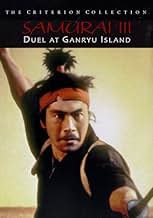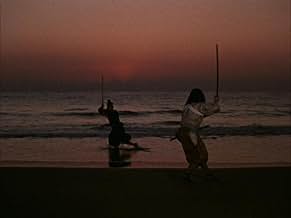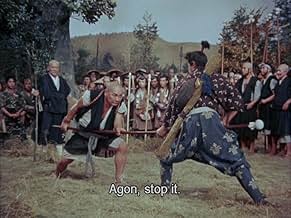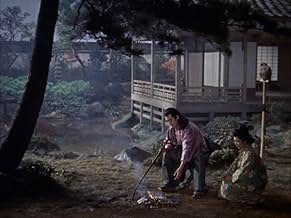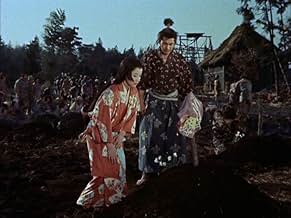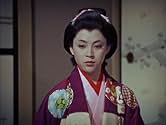La Voie de la lumière
Original title: Miyamoto Musashi kanketsu-hen: Kettô Ganryû-jima
- 1956
- Tous publics
- 1h 45m
IMDb RATING
7.5/10
7K
YOUR RATING
Musashi Miyamoto is challenged to a duel by a confident swordsman Sasaki Kojiro. He agrees to fight him in a year's time.Musashi Miyamoto is challenged to a duel by a confident swordsman Sasaki Kojiro. He agrees to fight him in a year's time.Musashi Miyamoto is challenged to a duel by a confident swordsman Sasaki Kojiro. He agrees to fight him in a year's time.
Featured reviews
"In the old days, I used to hate farm work. I was always daydreaming, longing for victory and renown. I could think of nothing else. Now I'm tilling the fields again. Isn't it strange? I'm beginning to learn the value of life."
In this film's opening scene, we see Sasaki Kojiro (Koji Tsuruta) tell his lover (Michiko Saga) that he must fight Miyamoto Musashi for no other reason than the two of them are the best samurai in Japan. They're in a beautiful place with waterfalls streaming down and a rainbow arcing gracefully overhead as he calmly states his purpose, something which immediately begs the question, why? He is in an Eden of sorts, and yet feels compelled to fight an honorable man, unprovoked, to death.
Meanwhile we see the spiritual growth of Musashi (Toshiro Mifune) in the very next scene, when he's willing to humble himself and apologize for an offense the boy who's travelling with him has committed. He consistently makes decisions to avoid battle if at all possible, even if the other guy has it coming to him. We see it here, the first time when Sasaki catches up with him in a cemetery, and when he simply shows an ornery guy his fly catching prowess with his chopsticks to let him draw his own conclusions about continuing to provoke him.
The two of these great samurai (who were indeed real 17th century historical figures) are destined to fight one another, though Musashi puts Kojiro off for year, delaying the inevitable. Does director Hiroshi Inagaki effectively fill in the time it takes to get to the titular battle over the film's 105 minutes? Somewhat. There are bandits who must be fought off, and then there are the love interests. Both Otsu (Kaoru Yachigusa) and Akemi (Mariko Okada) are still carrying a torch for Musashi, and arrive in the rural area where he's taken up the simple life of farming. Personally I thought Akemi's character, the fallen woman who men have "made a plaything of," was muddled and added unnecessary melodrama. I think the film would have been stronger had she not been present, or shown instead fading into the ignominy of prostitution. Regardless, this third and last film in the trilogy suffers from some of the same problems its predecessors did, with the two women throwing themselves at his feet in what started to feel like filler until we got to the final battle (though I did like the resolution for Otsu).
The film is visually quite beautiful, with shots in a cemetery, reflections in the water, and walking past Mt. Fuji coming to mind. The poetry and precision of both lead actors striking samurai poses and movements should also be in that list, and nowhere is it done better than in their final battle, which brought the film full circle back to its beginning. There is something symbolic in this fight taking place out on the beach at sunset as the timeless waves gently roll in, oblivious to the human drama. Musashi recognizes it, and it's why he weeps. He weeps for the pointlessness of it, he weeps for mankind's insatiable urge to dominate or kill when it isn't necessary. His spiritual journey is complete, and he'll go back to Otsu and farming, not looking for trouble as he did so brashly at the beginning of the first film. He's enlightened, but how can we hope for humanity when there will always be another Kojiro?
In this film's opening scene, we see Sasaki Kojiro (Koji Tsuruta) tell his lover (Michiko Saga) that he must fight Miyamoto Musashi for no other reason than the two of them are the best samurai in Japan. They're in a beautiful place with waterfalls streaming down and a rainbow arcing gracefully overhead as he calmly states his purpose, something which immediately begs the question, why? He is in an Eden of sorts, and yet feels compelled to fight an honorable man, unprovoked, to death.
Meanwhile we see the spiritual growth of Musashi (Toshiro Mifune) in the very next scene, when he's willing to humble himself and apologize for an offense the boy who's travelling with him has committed. He consistently makes decisions to avoid battle if at all possible, even if the other guy has it coming to him. We see it here, the first time when Sasaki catches up with him in a cemetery, and when he simply shows an ornery guy his fly catching prowess with his chopsticks to let him draw his own conclusions about continuing to provoke him.
The two of these great samurai (who were indeed real 17th century historical figures) are destined to fight one another, though Musashi puts Kojiro off for year, delaying the inevitable. Does director Hiroshi Inagaki effectively fill in the time it takes to get to the titular battle over the film's 105 minutes? Somewhat. There are bandits who must be fought off, and then there are the love interests. Both Otsu (Kaoru Yachigusa) and Akemi (Mariko Okada) are still carrying a torch for Musashi, and arrive in the rural area where he's taken up the simple life of farming. Personally I thought Akemi's character, the fallen woman who men have "made a plaything of," was muddled and added unnecessary melodrama. I think the film would have been stronger had she not been present, or shown instead fading into the ignominy of prostitution. Regardless, this third and last film in the trilogy suffers from some of the same problems its predecessors did, with the two women throwing themselves at his feet in what started to feel like filler until we got to the final battle (though I did like the resolution for Otsu).
The film is visually quite beautiful, with shots in a cemetery, reflections in the water, and walking past Mt. Fuji coming to mind. The poetry and precision of both lead actors striking samurai poses and movements should also be in that list, and nowhere is it done better than in their final battle, which brought the film full circle back to its beginning. There is something symbolic in this fight taking place out on the beach at sunset as the timeless waves gently roll in, oblivious to the human drama. Musashi recognizes it, and it's why he weeps. He weeps for the pointlessness of it, he weeps for mankind's insatiable urge to dominate or kill when it isn't necessary. His spiritual journey is complete, and he'll go back to Otsu and farming, not looking for trouble as he did so brashly at the beginning of the first film. He's enlightened, but how can we hope for humanity when there will always be another Kojiro?
This comment flows out from previous ones.
In cinematic terms, the trilogy looks to both East and West. West: the Hollywood western feel and tone of romantic adventure in a lawless land. Usually in a western this is rooted in landscape, the vast expanse of sky and desert that crystallizes being, which reflects Western notions of god. By contrast here, the landscape is fluid and dynamic: a recurring and important motif is transient bodies of water, and often bridges, human effort to ford time.
This is how each film ends, With these evocative shots of running waters as lovers part with the tides. The last shot leaves Musashi on a boat and we're unsure where the tides bring him next. Oh, a lot of the film is otherwise steeped in studio-lot artifice, you will often see for instance painted skies and sunsets.
The underlying visual inspiration is Japanese ukiyo-e. Buddhist- inspired in its original context, images (often of water or bridges) reflected this floating world of sorrows and melancholy yearning. We see this in Musashi's own journey of mastering self, reaching here the almost ascetic contentment of working the land.
Mizoguchi was more somberly portraying this floating world at the time. Later jidaigeki would more bitterly question the heroism and samurai devotion. Here it is a rustic, straightforward rendition in keeping with public perception of Musashi as a straight soul; so are the images, so is the drama. Handcarving, folk instead of high art. The iconography has been given specific care to emulate idyllic perceptions of Musashi's time.
So, a heroic story of romanticized legend, acted by a great Mifune, who like Musashi, had an intuitive rather than studied grasp of life. Told by referencing artistic tradition of that time which is romanticized by the same step, which is (roughly) the same distance in time to us.
---
The trilogy doesn't mine in a cinematic way Musashi's rich ideas about the 'Way', expressed in writing near the end of his life and passed on to a student. Musashi of course wrote on swordsmanship. Roughly speaking, his teaching is layered in the following way: realizing the many crafts as one, right technique, right strategy, refutation of flawed strategy, void as principle. (meant in the Buddhist way)
Musashi did not intend to establish a rigidly complicated system of study, but rather quickly sketch a practical handbook for the continuation of his school. He was not a learned scholar, nor from the Buddhist standpoint a spiritual master. His writings are not artistic. When he says 'cut the opponent with a void spirit', it is not metaphor, poetry or metaphysics. He is trying to distill an experiential state of mind.
The specifics of fighting do not interest us here, an abstract look at first principles should. The idea is that fighting before we even get to blows is two viewers coming together, establishing a situation. Referred to in the books as strategy, what Musashi is talking about is ways to manipulate the psychology of the situation.
Some it is makes amazing common sense, for instance approach the other feigning a lazy or weak demeanor then close the gap in the last steps with an explosive burst, what he calls 'getting someone drunk'. There are all sorts of this if you read carefully; 'passing on' mental states, creating mental states in the other, picturing yourself as the other, all to control and direct perception.
It seems what rules in these and other instances is the enigmatic 'twofold gaze', perception and sight. What can this be? Musashi does not explain, but I think it's this; grasping the difference and, ultimately, the inseparability of seeing and perception as the whole stageplay carried on in the mind's eye. Actually experience this. This is a bit like: sight is the calm lake before you while perception, the fact that a self is actively engaged in perceiving, a self which can experience fear or arrogance, is constantly throwing pebbles in that lake, distorting the surface.
We have similar notions in the West of how the latter bends the first. But Musashi is worth studying for the purely intuitive immediacy of the imports, it was after all something he learned as a matter of life and death.
This is observing dynamics instead of trying to decipher intent, theorizing. Fixing the eyes but not stopping the mind coming and going, cultivating an inquisitive and broad spirit. The idea is that none of this is an idea, but something that can be practiced and observed. That's also the Tao. The practice of perceiving the inner self of things through the outside form.
In cinematic terms, the trilogy looks to both East and West. West: the Hollywood western feel and tone of romantic adventure in a lawless land. Usually in a western this is rooted in landscape, the vast expanse of sky and desert that crystallizes being, which reflects Western notions of god. By contrast here, the landscape is fluid and dynamic: a recurring and important motif is transient bodies of water, and often bridges, human effort to ford time.
This is how each film ends, With these evocative shots of running waters as lovers part with the tides. The last shot leaves Musashi on a boat and we're unsure where the tides bring him next. Oh, a lot of the film is otherwise steeped in studio-lot artifice, you will often see for instance painted skies and sunsets.
The underlying visual inspiration is Japanese ukiyo-e. Buddhist- inspired in its original context, images (often of water or bridges) reflected this floating world of sorrows and melancholy yearning. We see this in Musashi's own journey of mastering self, reaching here the almost ascetic contentment of working the land.
Mizoguchi was more somberly portraying this floating world at the time. Later jidaigeki would more bitterly question the heroism and samurai devotion. Here it is a rustic, straightforward rendition in keeping with public perception of Musashi as a straight soul; so are the images, so is the drama. Handcarving, folk instead of high art. The iconography has been given specific care to emulate idyllic perceptions of Musashi's time.
So, a heroic story of romanticized legend, acted by a great Mifune, who like Musashi, had an intuitive rather than studied grasp of life. Told by referencing artistic tradition of that time which is romanticized by the same step, which is (roughly) the same distance in time to us.
---
The trilogy doesn't mine in a cinematic way Musashi's rich ideas about the 'Way', expressed in writing near the end of his life and passed on to a student. Musashi of course wrote on swordsmanship. Roughly speaking, his teaching is layered in the following way: realizing the many crafts as one, right technique, right strategy, refutation of flawed strategy, void as principle. (meant in the Buddhist way)
Musashi did not intend to establish a rigidly complicated system of study, but rather quickly sketch a practical handbook for the continuation of his school. He was not a learned scholar, nor from the Buddhist standpoint a spiritual master. His writings are not artistic. When he says 'cut the opponent with a void spirit', it is not metaphor, poetry or metaphysics. He is trying to distill an experiential state of mind.
The specifics of fighting do not interest us here, an abstract look at first principles should. The idea is that fighting before we even get to blows is two viewers coming together, establishing a situation. Referred to in the books as strategy, what Musashi is talking about is ways to manipulate the psychology of the situation.
Some it is makes amazing common sense, for instance approach the other feigning a lazy or weak demeanor then close the gap in the last steps with an explosive burst, what he calls 'getting someone drunk'. There are all sorts of this if you read carefully; 'passing on' mental states, creating mental states in the other, picturing yourself as the other, all to control and direct perception.
It seems what rules in these and other instances is the enigmatic 'twofold gaze', perception and sight. What can this be? Musashi does not explain, but I think it's this; grasping the difference and, ultimately, the inseparability of seeing and perception as the whole stageplay carried on in the mind's eye. Actually experience this. This is a bit like: sight is the calm lake before you while perception, the fact that a self is actively engaged in perceiving, a self which can experience fear or arrogance, is constantly throwing pebbles in that lake, distorting the surface.
We have similar notions in the West of how the latter bends the first. But Musashi is worth studying for the purely intuitive immediacy of the imports, it was after all something he learned as a matter of life and death.
This is observing dynamics instead of trying to decipher intent, theorizing. Fixing the eyes but not stopping the mind coming and going, cultivating an inquisitive and broad spirit. The idea is that none of this is an idea, but something that can be practiced and observed. That's also the Tao. The practice of perceiving the inner self of things through the outside form.
Samurai III boasts far superior color and composition to the first installment. The opener includes a beautiful scene of Kojiro and Akemi by a magnificent waterfall. This sets the stylistically polished tone of the film, a nice attempt to revive our interest in the sometimes-stalling narrative (Will Kojiro fight the indestructible Musashi? Is Otsu going to get her man after spurning his inviting advances?)
In terms of eye candy, this finale gives the most exotic colors (some may complain as "un-Japanese"), the best lighting, and the most skin of Mifune's Musashi! The story continues with the intellectual and spiritual education of Musashi. Even though the final duel is set up to be his moment of self-realisation, it is preceded by a tad-curious sequence of Musashi's farmlife. Very reminiscent of the samurai-villager relationship in Seven Samurai, Musashi becomes their protector against bandits. The result is formulaic but does what the story intends: return Musashi to a life of the earth - a humanist existence preached by his Buddhist education - and to his humble origin.
P.S. Although Miyamoto Musashi/Samurai I is crucial to understanding the rise of our hero, it probably got Best Foreign film for 1955 Academy Awards during the sudden "discovery" of Japanese films starting with Rashomon.
And if you're looking for a female figure with as much spunk as Musashi himself, note the courtesan in Samurai II. Her chastisement of Musashi, that he lacks humanly affection and thinks of women as weaklings, almost makes up for the overall iffy portrayal of "romantic heroines" in the trilogy!
In terms of eye candy, this finale gives the most exotic colors (some may complain as "un-Japanese"), the best lighting, and the most skin of Mifune's Musashi! The story continues with the intellectual and spiritual education of Musashi. Even though the final duel is set up to be his moment of self-realisation, it is preceded by a tad-curious sequence of Musashi's farmlife. Very reminiscent of the samurai-villager relationship in Seven Samurai, Musashi becomes their protector against bandits. The result is formulaic but does what the story intends: return Musashi to a life of the earth - a humanist existence preached by his Buddhist education - and to his humble origin.
P.S. Although Miyamoto Musashi/Samurai I is crucial to understanding the rise of our hero, it probably got Best Foreign film for 1955 Academy Awards during the sudden "discovery" of Japanese films starting with Rashomon.
And if you're looking for a female figure with as much spunk as Musashi himself, note the courtesan in Samurai II. Her chastisement of Musashi, that he lacks humanly affection and thinks of women as weaklings, almost makes up for the overall iffy portrayal of "romantic heroines" in the trilogy!
This was, by far the best of the trilogy and a fine ending. It had less Samurai action that the other two, but it was much more inspiring.
Kojiro (Koji Tsuruta) thought himself the best in the land and sought a duel with Musashi (Toshirô Mifune). But Musashi wanted to devote his life to becoming a better person. he went back to the land that he rejected and became a farmer.
In the meantime, both Otsu (Kaoru Yachigusa) and Akemi (Mariko Okada) managed to find him. Can you imagine that scene? Feeling rejected, Akemi is made to betray Musashi to the brigands. The effort fails and Musashi accepts the duel with Kojiro.
The duel itself was magnificent but short. It was a fitting end to a film that featured outstanding cinematography and a compelling story of the drive to perfection.
Kojiro (Koji Tsuruta) thought himself the best in the land and sought a duel with Musashi (Toshirô Mifune). But Musashi wanted to devote his life to becoming a better person. he went back to the land that he rejected and became a farmer.
In the meantime, both Otsu (Kaoru Yachigusa) and Akemi (Mariko Okada) managed to find him. Can you imagine that scene? Feeling rejected, Akemi is made to betray Musashi to the brigands. The effort fails and Musashi accepts the duel with Kojiro.
The duel itself was magnificent but short. It was a fitting end to a film that featured outstanding cinematography and a compelling story of the drive to perfection.
I feel very confident and content once I finished watching the trilogy. What starts of a nothing end on greatness. Lots of things have been said in the movie about the humans, the way they live, they behave, they treat others and above all their desires grooved in the very depth of the heart. What is most likable is the mildness with which things are being said but every bit needs to be heard with full attention. After watching the trilogy I read the book written by Miyamoto (A book of five rings Must read) himself and got an inside more clearly.
Now the movies, all three are gems without a second thought. The acting, cinematography and above all the direction is very good. Emphasis on little things, shades of lights (sun is setting etc) and even water (streams, rivers) everything is perfectly matched with the movie to the core. Above all is the way Mifune enacted the role, the way he delivers the expressions for an arrogant in the first outing, then the confused man and in the last gentle, kind and wise person is extremely believable and I have no doubt in saying that I can't imagine someone else in the role.
A must watch trilogy.
8.5/10 (all three movies)
Now the movies, all three are gems without a second thought. The acting, cinematography and above all the direction is very good. Emphasis on little things, shades of lights (sun is setting etc) and even water (streams, rivers) everything is perfectly matched with the movie to the core. Above all is the way Mifune enacted the role, the way he delivers the expressions for an arrogant in the first outing, then the confused man and in the last gentle, kind and wise person is extremely believable and I have no doubt in saying that I can't imagine someone else in the role.
A must watch trilogy.
8.5/10 (all three movies)
Did you know
- TriviaThis film is part of the Criterion Collection, spine #16.
- GoofsAs the final duel is fought, the duelists have light on the sides of their bodies away from the sun - Sasaki has light on his back and Miyamoto light on his face.
- Quotes
Musashi Miyamoto: Brace up, Akemi.
- ConnectionsFeatured in Sayonara Jupitâ (1984)
- How long is Samurai III: Duel at Ganryu Island?Powered by Alexa
Details
- Release date
- Country of origin
- Language
- Also known as
- Samurai III: Duel at Ganryu Island
- Filming locations
- Production company
- See more company credits at IMDbPro
- Runtime1 hour 45 minutes
- Sound mix
- Aspect ratio
- 1.37 : 1
Contribute to this page
Suggest an edit or add missing content



